That NASA sent the Hubble into space, to stay.
The date was 24 April, 1990; “Liftoff of the Space Shuttle Discovery, with the Hubble Space Telescope, our window on the universe”.
Over the next ten days I’ll be reviewing these twenty years, starting with the first two today; I hope you will enjoy the show.
Of course, the Hubble’s history goes back many years before 1990; astrophysicist Lyman Spitzer is credited with the first paper proposing a space-based optical observatory, in 1946! He spent a good half century working on the idea (Trivia fact: Spitzer really knew his plasma physics; among other things he founded the Princeton Plasma Physics Laboratory, in 1951; the PPPL is home to some exciting magnetic reconnection experiments). Not so well-known, in the US at least, is that European involvement in the Hubble – via the European Space Agency (ESA) – dates from 1975, 15 years before its launch (Trivia fact: ESA’s Space Telescope European Coordinating Facility (ST-ECF) issued its first newsletter in March 1985).
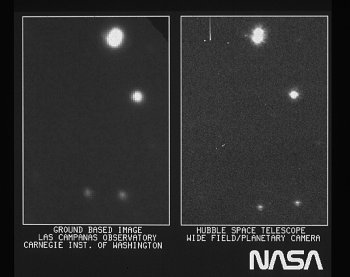
For all the brilliant engineering, the best money could buy, the Hubble’s primary mirror was ground to exquisite precision and accuracy … but precisely and accurately wrong; the “presence of significant spherical aberration” was announced by NASA at the end of June, 1990. (Trivia fact: the cause of the mis-grinding was a field lens in the reflective null corrector used to test the figure of the primary mirror; it was “mis-located by about 1.3mm” Did heads roll as a result?)
However, because the primary mirror was ground so precisely and accurately, if wrongly, images sent back from the Hubble could be processed to largely remove the unintended blur, and so after a half year or so of rather intense work, the scientific show did go on.
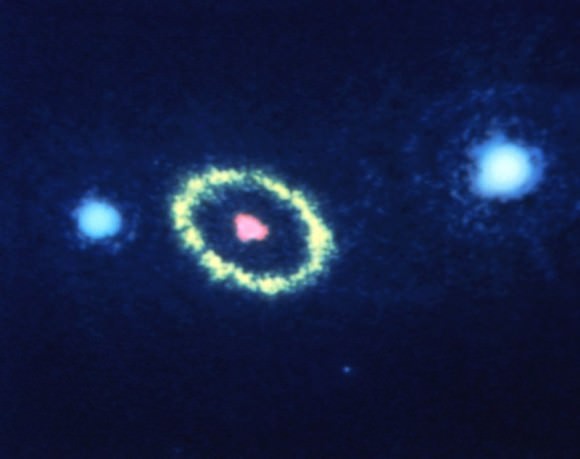
And what a show it was!
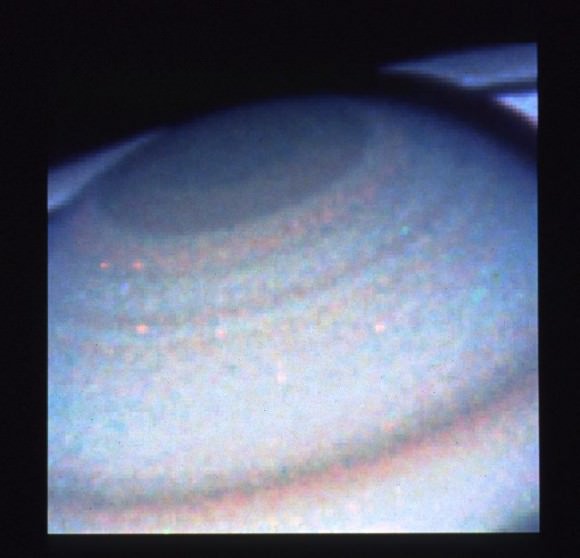
Take a trip down memory lane, check out Hubble’s image of Saturn’s North Polar Hood; it’s zoomable!
But a faulty mirror and image processing are not quite the real thing; sometimes there are image processing artifacts, as this 1991 image of a nearby supernova-to-be shows:
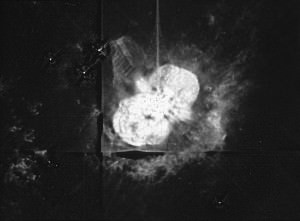
Of course it wasn’t only pretty pictures that the Hubble returned to Earth; a great many papers based on the astronomical data from the Hubble were published in its first two years of operation, covering a wide range of topics (perhaps I’ll base a future Universe Puzzle on this, maybe ‘what was the first such paper?’). And it wasn’t only images; the Hubble carried an instrument called the Faint Object Spectrograph, which worked in a part of the electromagnetic spectrum accessible only from space, the far ultraviolet (click on this link to read about limits on He I emission, the He I Gunn-Peterson effect, and Ly-alpha absorption spectrum “at z roughly 0.5”).
What’s your favorite from the first two years?

Mine’s The Ultraviolet Absorption Spectrum of 3C 273; not only is about the iconic quasar 3C 273, not only is it a classic John Bahcall paper (he writes so well!), not only does it illustrate well the scientific power of spectroscopy, but shines a light on composition of the intracluster medium.
Tomorrow: 1992 and 1993, including COSTAR and the first servicing mission.
Sources: HubbleSite, European Homepage for the NASA/ESA Hubble Space Telescope, The SAO/NASA Astrophysics Data System

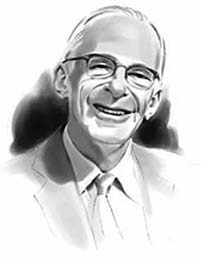
Was there any other unmanned vehicle that could launch the HST? Was the shuttle the only one capable of this?
The reason I ask is, given the cost of launching each shuttle launch compared to an unmanned lifter, and the number of components that have been replaced (cameras, gyroscopes, solar panels etc), would it have been comparable in cost to launch a new telescope instead?
Each shuttle mission to the HST involved sending humans up and replacing a good part of the telescope. If we assume an unmanned launcher costs less, the savings could have gone to building a new HST.
The HST is a bulky piece of equipment so the shuttle may have been the only way to send it up.
I don’t know about 1990, but such a large, massive, payload can certainly be launched today.
However, the main considerations, back then, surely had more to do with a need for the Shuttle program to work (or, perhaps, strong optimism that it would). And in any case, the design decisions for the Hubble were made well before 1990 (accessibility to repair and upgrade, by the Shuttle, was a key feature of that design).
Oh, and the cost of the Hubble itself was pretty big, certainly much greater than the cost of a Shuttle launch, so I don’t think much could have been saved by launching a new one every time one already in orbit failed!